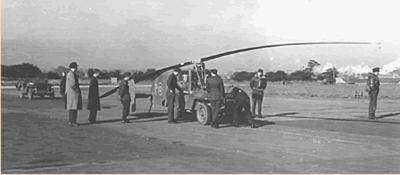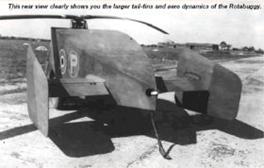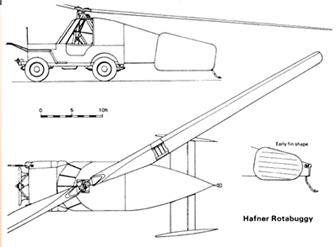Flying Jeep
In the early 1940s flight tests had been carried out on a number of one-man gliders known as Rotachutes.
During this time Raoul Hafner decided to apply the same principle on a larger-scale military vehicle. On 3 April 1942 the Rotary Wing Section of the Airborne Forces Experimental Establishment AFEE) at Ringway, Manchester, submitted a proposal for the application of the system to the Blitz Buggy’ or Jeep.


Here you can see the inside of the cab/cockpit. A few too many gauges/levers for the average Jeep.
The advantages of rotary -wing system were seen as simplicity, cheapness, and the feasibility to land in very confined spaces. Towing speeds of up to 160mph and a load-carrying capacity of up to 3,500lb with a 50ft rotor diameter were predicted.


The design work was carried out by AFEE staff, while most of the construction was undertaken by R. Malcolm Ltd, with H. Morris & Sons assisting in the manufacture of the rubber hub. The serial numbers RD123 and RD127 were allotted for the two ‘Malcolm Blitz Buggys’, although they were never to be used. The basic Jeep was fitted with a pylon to support the two-bladed rotor and a fairing to carry the tail surfaces. The Rotabuggy’, as it became known, was to carry a pilot and a small load, together with a complete tankage of fuel and spare wheel, spare tank, tools and snow chains. The pilot occupied the starboard front seat, but an alternative arrangement for a second pilot was made in the port seat with dual controls.

Initial rotation of the rotor before take-off was achieved by use of a starting cable pulled second car, and rotation in flight was maintained by the airflow through the rotor disc. While the Rotabuggy needed a low c.g. to ensure a fair ground stability on landing, it was also essential that there was sufficient ground clearance for the rotor during taxiing, take-off or landing.

The tail fairing was a plywood monocoque structure attached at four points to the rear of the Jeep and cabin. Because consideration loads were transmitted through the fairing in some conditions of flight and in heavy landing, the Jeep was strengthened locally at the points of attachment. The twin-spar tailplane had trimming flaps on either side which were adjustable on the ground by means of turnbuckles. Large endplate fins were set at a slight angle in plain view to give incidence relative to the local airflow. 
Replacing the standard Jeep windscreen was a streamlined sheet metal framework with Perspex sheets. The remainder of the cabin was built of plywood. Access doors with large Perspex panels were fitted both sides. A hole in the cabin roof accommodated the pylon, with allowances for movement owing to the elastic suspension. In the ‘cockpit’ a special dashboard on the starboard side contained an airspeed indicator, a rotor speed indicator, a sensitive altimeter and a turnand- slip indicator. A standard telephone system via the towrope allowed the pilot to communicate with the tug pilot, the amplifier and batteries being located behind the starboard seat.

To test the performance of the rotor, it was mounted on a pylon attached to a Diamond T lorry, which was heavy enough to resist overturning when acted upon by the lift of the rotor. To start the rotor the lorry was driven forward slowly into wind while a number of men pulled on the starting cable at the rear. About 60 rpm was obtained, after which the rotor speed could be varied by varying the lorry’s speed. The first trial, a ground run, took place at Sherburnin- Elmet, Yorkshire, England on 16th November 1943, using the same lorry with a maximum speed of 24 mph. Unfortunately the lorry lacked speed, so the test pilot Sqn Ldr I.M.D Little, was sent to London to buy a faster vehicle. He came back with a 4.5 litre Bentley, which had just enough power to do the job. After three more ground runs the front wheels did leave the ground and Little took the Rotabuggy into the air for the first time at a speed of 37mph on 27th November.
The next flight on 8th December was made using a Whitley V bomber as the tug, but due to increased speeds, the Jeep began to vibrate at speeds of around 50mph. So the Bentley was brought back in on 12th January 1944. After two more trials the rotor broke a tail fin. A few days later two more flights were made, but the vibration was still unpleasant.
Then after two more Bentley tows, another trial using the Whitley took place, and this time it flew at a speed of 35-40mph. Later that same day (now 30th January) it reached a speed of 45mph. In a Whitley tow in the 1st February a flying speed of 70mph was reached. Flight tests continued using both car and plane, until test number 30, when after being towed behind the Bentley, the Jeep landed normally, but then swung through a 170 degree to starboard.
Both blades struck the ground and 3ft of each rotor broke away and caused the Jeep to shake violently. Little was unhurt, but his passenger, Mr Walker, suffered concussion and broken ribs.
New blades were made by the 20th of March, and more tests were carried out, with several modifications being made. After almost 60 test flights, the big day came on 11th September 1944, when Little took to the wheel, towed behind the Whitley. A seven to ten minute full free flight was achieved and the Jeep reached a height of 400 feet, at a speed of 65mph and landed successfully ‘although precariously’.
However, this day turned out to be its last flight for Rotabuggy.

Basic sketch drawings of the Hafner Rotabuggy.